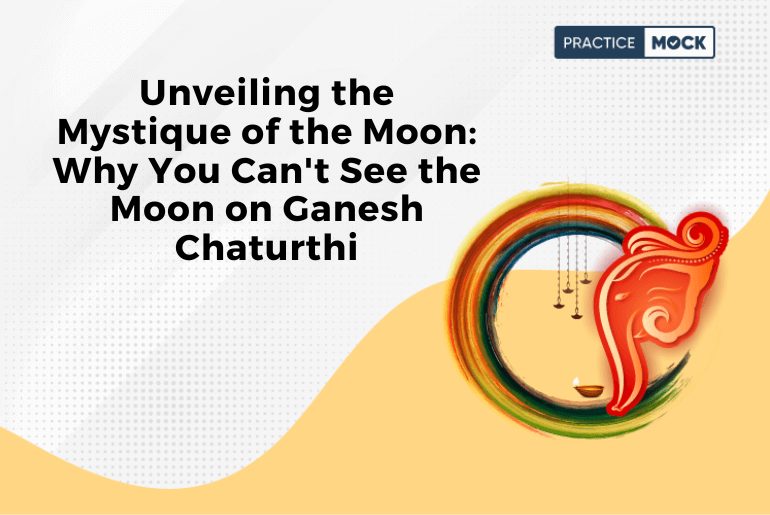

Ganesh Chaturthi, the vibrant and fervently celebrated Hindu festival, is marked by a unique tradition that has intrigued many—the belief that the moon cannot be seen on this auspicious day. While science provides a rational explanation for moon visibility, the cultural and mythological significance of Ganesh Chaturthi moon-viewing, or rather the avoidance of it, remains steadfast.
सुख करता दुख हर्ता, वार्ता विघ्नाची |
नूर्वी पूर्वी प्रेम कृपा जयाची ||
सर्वांगी सुन्दर उटी शेंदु राची |
कंठी झलके माल मुकताफळांची ||
Ganesh Chaturthi Moon: The Mythological Tale
At the heart of this tradition lies a captivating mythological narrative—one that involves the beloved deity Lord Ganesha and the radiant moon. The story, steeped in symbolism, imparts profound lessons and bestows spiritual wisdom upon those who delve into its depths.
According to Hindu mythology, Goddess Parvati, the divine consort of Lord Shiva, crafted Lord Ganesha from her own bodily elements, sculpting him with love and devotion. She charged Ganesha with the responsibility of guarding her chamber while she indulged in her ablutions.
The pivotal moment arrives when Lord Shiva, returning to the divine abode, endeavors to enter Parvati’s chamber. Unbeknownst to him, Ganesha, the vigilant guardian, obstructs his path. A confrontation between the two ensues, and in the heat of the moment, Shiva, the powerful deity wielding celestial weapons, severs Ganesha’s head with his mighty trident.
The repercussions of Shiva’s impulsive act immediately engulf the divine abode in sorrow and remorse. To mend this grievous error and to restore life to Ganesha, Shiva and the gods embarked on a quest to find a suitable replacement head. Their quest culminated in the discovery of an elephant’s head, which was seamlessly affixed to Ganesha’s body, resurrecting him as the elephant-headed god we revere today.
While this narrative showcases the resilience of Lord Ganesha, his transformation into a deity, and the significance of the elephant’s head, it also addresses the moon’s role in the story. According to legend, the moon, being a witness to these events, found humor in the peculiar visage of the newly revived Ganesha. It is said that the moon’s laughter and mocking gaze infuriated Ganesha, who in his divine ire, cast a curse upon the moon.
This curse ordained that anyone who set eyes upon the moon on Ganesh Chaturthi would incur the wrath of Lord Ganesha and face slanderous accusations of theft, ignominy, and humiliation. Thus, the tradition was born—devotees refrained from gazing at the moon on this day to avoid invoking Ganesha’s displeasure.
Cultural and Spiritual Significance:
The avoidance of moon sightings on Ganesh Chaturthi carries profound cultural and spiritual meaning within the Hindu community:
- Reverence for Lord Ganesha: The tradition exemplifies the deep respect and devotion devotees hold for Lord Ganesha, reinforcing his status as the remover of obstacles and the granter of wisdom.
- Mythological Lessons: The story of Ganesha’s creation and transformation underscores vital themes such as redemption, forgiveness, and the consequences of impulsive actions. It serves as a spiritual parable, imparting timeless wisdom.
- Preservation of Tradition: Hinduism, rich with traditions and rituals, places immense importance on preserving cultural heritage. Following customs like avoiding moon sightings on Ganesh Chaturthi helps sustain these age-old practices.
- Community Unity: Ganesh Chaturthi, celebrated with great zeal and communal fervor, binds people together in a shared cultural experience. Abiding by the moon-avoidance tradition fosters unity and a sense of belonging among devotees.
Scientific Perspective on Ganesh Chaturthi Moon Visibility:
From a scientific perspective, the moon’s visibility on Ganesh Chaturthi remains unchanged, following its natural orbit and phases. The moon operates independently of human festivals and beliefs. It waxes and wanes, illuminating the night sky as it has for millennia.
In conclusion, the belief that the moon cannot be seen on Ganesh Chaturthi is an enchanting fusion of mythology, culture, and spirituality. Rooted in a compelling narrative, it serves as a reminder of devotion, humility, and the enduring wisdom encapsulated in Hindu mythology. Whether observed out of faith or as a cultural practice, it deepens the significance of Ganesh Chaturthi, contributing to the tapestry of traditions that enrich Hindu culture and spirituality.
Recent Posts
500+ GA Important Questions For IDBI JAM PGDBF 2025 Exam
In this article we are providing the 500+ GA Important Questions For IDBI JAM PGDBF…
Which is Easier to Crack, the RBI Grade B or the NABARD Grade A?
Wondering which exam is easier to crack: RBI Grade B or NABARD Grade A? Find…
SSC CGL Reasoning Mock Test Free Based On Previous Year Question Papers
In this blog, we have provided the SSC CGL Reasoning Mock Test Free Based On…
SSC CGL Quant Previous Year Questions, Free PDF & Topic-Wise Tests
In this blog, we have provided the SSC CGL Quant Previous Year Questions. You can…
SSC CGL Reasoning Previous Year Questions, Free PDF & Topic-Wise Tests
In this blog, we have provided the SSC CGL Reasoning Previous Year Questions in the…
RBI Grade B Notification 2025, Eligibility, Exam Date, Online Form
Get all the information you need about RBI Grade B 2025 Notification, including Exam Date,…


